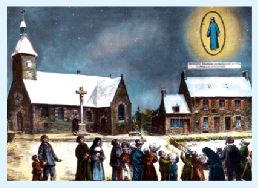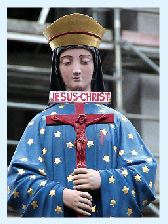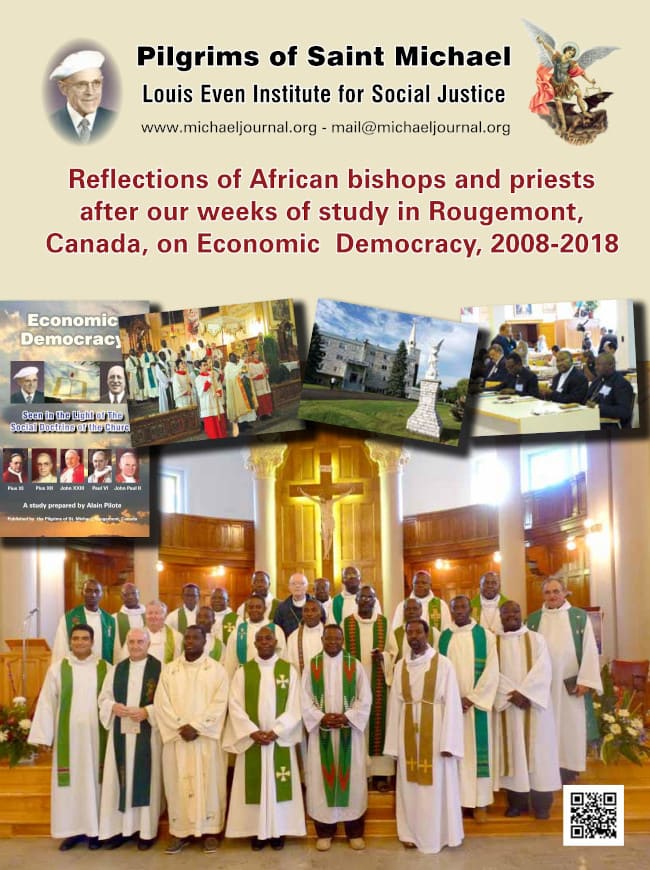 On July 19, 1870, Emperor Napoleon III of France declared war against Prussia. From the first days of the war, defeat followed defeat. By January 1871, Paris was under siege, two-thirds of the country was in the power of the Prussians, and they were advancing towards the west of France. By January 17, 1871, the Prussians were just across the river from Laval, which is the city next to Mayenne.
On July 19, 1870, Emperor Napoleon III of France declared war against Prussia. From the first days of the war, defeat followed defeat. By January 1871, Paris was under siege, two-thirds of the country was in the power of the Prussians, and they were advancing towards the west of France. By January 17, 1871, the Prussians were just across the river from Laval, which is the city next to Mayenne.
Towards the evening of January 17, Pontmain, a small town in the north of Mayenne, lay under a blanket of snow. Though the roar of cannon could be heard, the Barbedette family was busy with their household chores before supper. In a barn in the middle of town two boys, Eugene, 12, and Joseph, 10, Barbedette, are helping their father feed the horses. Some minutes before six o’clock in the evening, taking advantage of a break from work, Eugene leaves the barn and sees in the sky a “Lady”. She spreads her lowered hands in a gesture of welcome and smiles on him.
Joseph comes along a few moments later and also sees the Lady. But the parents of the boys see nothing. The Sisters of the school are called. Again, they see nothing. But two little girls with them, Frances Richer, 11, Jeanne Marie Lebosse, 9, do see the beautiful Lady.
The Lady, as described by Eugene, was dressed in a flowing robe of deep radiant blue studded with gold stars. The sleeves were full, extending up to the hands. She was wearing blue slippers, tied with golden ribbon in the shape of a rosette. Her hair was completely covered with a black veil thrown over her shoulders reaching down to the level of her elbow. On her head, a gold crown rose slightly to a peak. It had no ornament in front except a red band circling the centre. Her hands were extended — “like the Miraculous Medal”, but without the rays of light.
From time to time the Lady would look sad because of some haughty and rowdy people in the crowd, but she would smile back, especially with the prayers and hymns, the Rosary and Marian songs of the people led by the parish priest, Father Guerin, and the two sisters. As the congregation was reciting the Rosary, stars gathered two by two, below the Lady’s feet as if representing the Hail Marys of the Rosary. Then a white banner, about a yard wide, unrolled beneath the Lady’s feet, thus forming a perfect rectangle. Here she spelled her message:
“OH! DO PRAY MY CHILDREN, GOD WILL ANSWER YOU VERY SOON. MY SON ALLOWS HIMSELF TO BE MOVED”
After some time, she raised her hands to the height of her shoulder, arms out and bent slightly backwards and elbows close to her body. Then a large red cross appeared in the hands of the Blessed Virgin. The figure of the crucified Christ was a darker red hue but no blood was flowing from the wounds. The community prayed their night prayers together. A large white veil began to cover the figure of the Virgin, slowly rising to her face and then she gave her last smile to the children. As the night prayers came to a close, the Apparition ended. It was about nine o’clock. The Apparition ended after lasting about three hours.
 In the meantime, late that night of January 17, General Von Schmidt of the Prussian Army who was about to run over Laval towards Pontmain, received orders from his Commander not to take the city. The invasion of the Catholic West never came off. On January 23, 1871, the long-hoped for Armistice was signed. The promise, “God will soon grant your request” of Our Lady of Hope, had been fulfilled. Soon all the thirty-eight conscripted men and boys of Pontmain returned home unscathed. General Schmidt is reported to have said on the morning of the 18th: “We cannot go farther. Yonder, in the direction of Brittany, there is an invisible ‘Madonna’ barring the way.”
In the meantime, late that night of January 17, General Von Schmidt of the Prussian Army who was about to run over Laval towards Pontmain, received orders from his Commander not to take the city. The invasion of the Catholic West never came off. On January 23, 1871, the long-hoped for Armistice was signed. The promise, “God will soon grant your request” of Our Lady of Hope, had been fulfilled. Soon all the thirty-eight conscripted men and boys of Pontmain returned home unscathed. General Schmidt is reported to have said on the morning of the 18th: “We cannot go farther. Yonder, in the direction of Brittany, there is an invisible ‘Madonna’ barring the way.”
On the Feast of the Purification, February 2, 1872, the Most Rev. Wicart, Bishop of Laval, issued a pastoral letter giving a canonical judgment on the Apparition. Thus, the veneration of Our Lady of Hope of Pontmain was given official Church recognition and approval. A basilica was built and consecrated on October 15, 1900.
source: www.sanctuaire-pontmain.com
 In this special issue of the journal, MICHAEL, the reader will discover who are the true rulers of the world. We discuss that the current monetary system is a mechanism to control populations. The reader will come to understand that "crises" are created and that when governments attempt to get out of the grip of financial tyranny wars are waged.
In this special issue of the journal, MICHAEL, the reader will discover who are the true rulers of the world. We discuss that the current monetary system is a mechanism to control populations. The reader will come to understand that "crises" are created and that when governments attempt to get out of the grip of financial tyranny wars are waged. An Efficient Financial System, written by Louis Even, is for the reader who has some understanding of the Douglas Social Credit monetary reform principles. Technical aspects and applications are discussed in short chapters dedicated to the three propositions, how equilibrium between prices and purchasing power can be achieved, the financing of private and public production, how a Social Dividend would be financed, and, finally, what would become of taxes under a Douglas Social Credit economy. Study this publication to better grasp the practical application of Douglas' work.
An Efficient Financial System, written by Louis Even, is for the reader who has some understanding of the Douglas Social Credit monetary reform principles. Technical aspects and applications are discussed in short chapters dedicated to the three propositions, how equilibrium between prices and purchasing power can be achieved, the financing of private and public production, how a Social Dividend would be financed, and, finally, what would become of taxes under a Douglas Social Credit economy. Study this publication to better grasp the practical application of Douglas' work.  Reflections of African bishops and priests after our weeks of study in Rougemont, Canada, on Economic Democracy, 2008-2018
Reflections of African bishops and priests after our weeks of study in Rougemont, Canada, on Economic Democracy, 2008-2018 The Social Dividend is one of three principles that comprise the Social Credit monetary reform which is the topic of this booklet. The Social Dividend is an income granted to each citizen from cradle to grave, with- out condition, regardless of employment status.
The Social Dividend is one of three principles that comprise the Social Credit monetary reform which is the topic of this booklet. The Social Dividend is an income granted to each citizen from cradle to grave, with- out condition, regardless of employment status.Rougemont Quebec Monthly Meetings
Every 4th Sunday of every month, a monthly meeting is held in Rougemont.